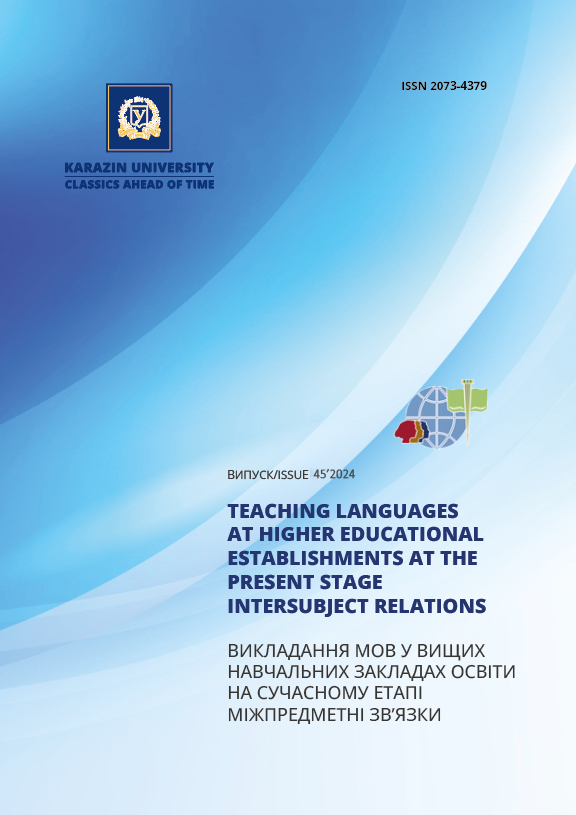Information technologies for the study of lexical and grammatical norms in the course “Ukrainian language for professional purposes”
Abstract
The article analyzes the current aspects of studying lexical and grammatical norms in the classes of the course “Ukrainian language for professional purposes” using information technologies. The authors consider the issue of developing and improving lexical and grammatical competence of higher education students as a requirement and basis for the culture of oral speech of a specialist. The purpose of the article is to analyze theoretical and methodological ways of studying lexical and grammatical norms using information technologies in the classes of the course “Ukrainian language for professional purposes”, as well as to study the problem of improving linguistic and communicative competence in higher education students in the context of the educational needs of the modern generation of “zoomers” in Ukraine, which, in addition to the global challenges associated with the COVID-19 pandemic, is forcibly exposed to the influence of social and demographic changes associated with the Russian-Ukrainian war.
In the article, the authors emphasize the need to take into account the specifics of studying this problem in the conditions of work of a higher education teacher with a generation of students aged approximately 17–22 years, that is, with the so-called virtual generation of “zoomers” (Gen-Z). This generation is characterized by a number of features that the teacher should consider. In particular, the article defines teaching methods that address the educational needs of a modern student.
For effective assimilation of the specified material, such methods are offered as: rapid change of type of activity, orientation on information technologies, individual approach, involvement in social interaction, gamification, interactive presentation of a new material, orientation on the visual rather than the auditory component, etc.
The most effective online resources were identified as: the educational platform “Vseosvita”, the graphic design tool “Canva”, the digital educational system “To the lesson”, the platform “Classtime”, the tool for creating educational cards “Quizlet”, etc. A typology of tasks possible for work on such platforms was proposed.
A promising direction for further research is the development of a database of tasks of different levels of complexity, narrow professional focus.
Downloads
References
Borshchovetska, V., Harbuza, T., Durdas, A., Semidotska, V. (2024). Cognitive, linguistic, and methodological considerations in teaching professional vocabulary to information technology (IT) students. Teaching Languages at Higher Educational Establishments at the Present Stage. Intersubject Relations. 44, pp. 12-27. DOI: https://doi.org/10.26565/2073-4379-2024-44-01 [in Ukrainian].
Kucherenko, I. (2024). Formation of spelling competence of higher education students. Teaching Languages at Higher Educational Establishments at the Present Stage. Intersubject Relations. 44, pp. 110-121. DOI: https://doi.org/10.26565/2073-4379-2024-44-07 [in Ukrainian].
Radomska, L., Vitkovskyi, M. (2024). Information resources for checking and correcting Ukrainian-language texts. Philological Review. 2(24), pp. 80-96. DOI: https://doi.org/10.31499/2415-8828.2(24).2024.317042 [in Ukrainian].
Svider, I.A. (2021). Information technologies in philology and translation. Kamianets-Podilskyi [in Ukrainian].
Ahmed, K., Romeo, J. (2023). A To Gen Z: What Your Business Needs To Know About Generation Z Right Now. Oliver Wyman Forum. Available at: https://www.oliverwymanforum.com/events/a-to-gen-z--what-your-business-needs-to-know-about-generation-z-.html [Accessed 07 Sept. 2024].
Fernández-Cruz, FJ., Fernández-Díaz, MJ. (2016). Тeachers Generation Z and their Digital Skills. Comunicar. Volume 24, Issue 46, pp. 97-105. DOI: https://doi.org/10.3916/C46-2016-10
Hidayat, R., Qi, TY., Ariffin, PNʼABT, Hadzri, MHB, Chin, LM, Nasir, N. (2024). Online game-based learning in mathematics education among Generation Z: A systematic review. International Electronic Journal of Mathematics Education. Volume 19, Issue 1. DOI: https://doi.org/10.29333/iejme/xxxx
Karasova, E., Uherková, M. (2023). Navigating the digital age: Exploring effective teaching and learning approaches for university students. Media and Marketing Identity: AI-the future of today. Pp. 184-193. DOI: https://doi.org/10.34135/mmidentity-2023-19
Kreacic, A., Romeo, J., Luon, S., Uribe, L., Lasater-Wille, A., Costa, E., Ahmed, K., Paterson, J. What Business Needs To Know About The Generation Changing Everything. A-Gen-Z Report. Available at: https://www.oliverwymanforum.com/content/dam/oliver-wyman/ow-forum/template-scripts/a-gen-z/pdf/A-Gen-Z-Report.pdf?fbclid=IwAR1UVKdpD-QcLr944ANJOdsE2vXly6aTnPRGMuTWpAS1A1v-tVINXBqQBZM [Accessed 14 Sept. 2024].
Mezeiova, А. (2019). Virtual generation in the University environement – its needsand requirements. Reproduction of Human Capital – mutual links and connections (RELIK 2019). Pp. 325-336.
Shorey, S., Chan, V., Rajendran, P., Ang, E. (2021). Learning styles, preferences and needs of generation Z healthcare students: Scoping review. Nurse education in practice. Volume 57. DOI: https://doi.org/10.1016/j.nepr.2021.103247
Zatserkovnyi, О. (2024). ICT integration in education: aligning experiences of ESP lecturers in economic universities. Teaching Languages at Higher Educational Establishments at the Present Stage. Intersubject Relations. 44, pp. 38-59. DOI: https://doi.org/10.26565/2073-4379-2024-44-03

